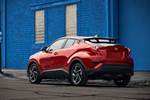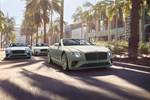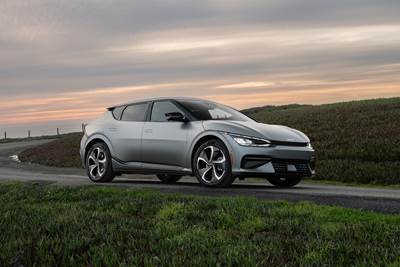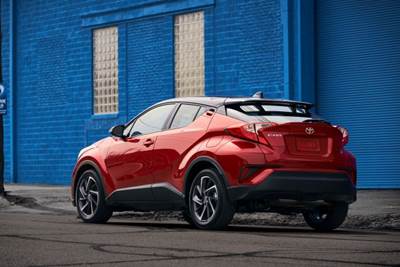on EV Fine Print, AI for PD, Designing the '23 Escape & More
Reading the EV footnotes. . .using AI for developing fuel tanks. . .driving the Hyundai Kona N. . .styling the ‘23 Ford Escape. . .Mercedes safety. . .Consumer Reports on safety in seating. . .the Ariel Hipercar. . .Electrify America using batteries. . .Bosch building EV motors. . .the Dodge performance strategy. . .
Share
Read Next
2024 GMC Sierra EV Denali Edition 1: Some Details
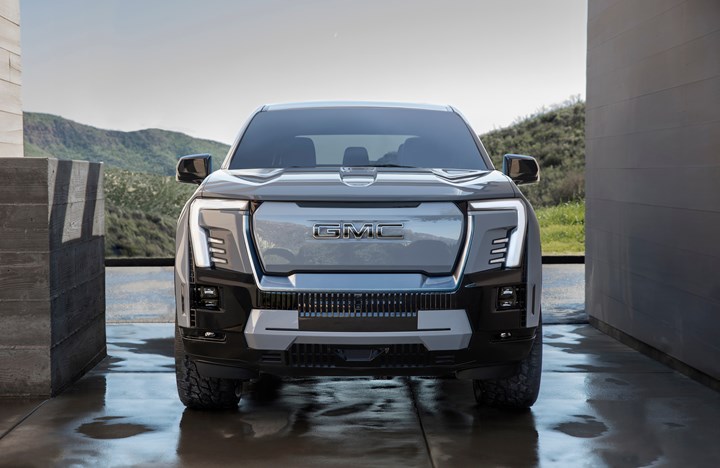
2024 GMC Sierra EV Denali Edition 1: GMC bringing another high-end truck to the EV market. (Image: GMC)
Either people (a) like to buy expensive electric vehicles or (b) like to place $100 reservation deposits on expensive electric vehicles or (c) something in between.
Last Thursday GMC announced the 2024 GMC Sierra EV Denali Edition 1. It has a starting MSRP of $107,000. Reservations opened and poof! the list (not announced how many slots were available) was full. Like a trendy restaurant, a waitlist was opened: "JOIN THE WAITLIST AND GET UPDATES Submit your information to get email notifications about Sierra EV.”
For those who obtained reservations and are going to go through with the additional $106,900, the trucks—which are to be built at the GM Factory ZERO Detroit-Hamtramck Plant, in which GM invested $2.2-billion to make it an EV factory (it is currently building the GMC HUMMER EV pickup and will be producing the ute version of that truck as well as the Chevrolet Silverado EV and the Cruise Origin autonomous people-transporter)—will become available in early 2024.
Key Factors
When announcing the truck, GMC cited four areas they are particularly proud of:
Next-Gen Power, Purposeful Technology, “Grille-to-Gate” Versatility, Modern Luxurious Appointments.
The Purposeful Technology includes such things as a 16,8-inch diagonal touch screen and Super Cruise hands-free driver assistance tech that works with a trailer. . .and speaking of trailering, the “Grille-to-Gate” includes up to 9,500 pounds of max towing. The Modern Luxurious Appointments are things like open-pore wood and a panoramic fixed glass roof.
Read the Fine Print
The Next-Gen Power is notable and interesting—because of the footnotes that accompany the items.
For example, “GM-estimated range of 400 miles (640 km) on a full charge.”
The footnote:
“GM-estimated range on a full charge for Sierra EV Denali Edition 1 based on current capability of analytical projection consistent with SAE J1634 revision 2017-MCT. Actual range may vary based on several factors, including temperature, terrain, battery age, loading and how you use and maintain your vehicle. EPA estimates not yet available.”
While things like temperatures, terrain, age, loading, vehicle use and maintenance all have effect on ICE engines (e.g., according to the U.S. Dept. of Energy, gas mileage when it is 20°F outside is typically 15% lower than when it is 77°F) seems like this tech might be a bit more touchy.
And: “Onboard Power Station Pro turns Sierra EV Denali into a mobile power source, with up to 10.2kW of off-board power that can be used in a variety of situations.”
Which goes with:
“When properly equipped. Requires accessory Ultium Power Bar.”
Not quite a “Batteries not included” because they are. But as an electrician pointed out to me, this isn’t a matter of simply plugging in the vehicle into an outlet in one’s house in the event of a power outage and volia! run the refrigerator. Work must be done on one’s home wiring setup in order to make that happen. And that includes the Ultium Power Bar option.
And Don’t Forget About Charging
One more:
“800 Volt DC Public Fast Charging capable at up to 350kW, enabling up to 100 miles of range in approximately 10 minutes— the best charging capability in the EV truck segment.”
The explanation there:
“Actual charge times will vary based on battery starting state of charge, battery condition, output of charger, vehicle settings and outside temperature. See the vehicle’s Owner’s Manual for additional limitations.”
The real kicker there has nothing to do with the vehicle so much as the charger. If the “800 Volt DC Public Fast Charging” unit can be located and if it isn’t being used by someone else, then there is the issue of it actually working.
According to the J.D. Power U.S. Electric Vehicle Experience Public Charging Study released in August: “one out of every five respondents [who went to a charge station] ended up not charging their vehicle during their visit. Of those who didn’t charge, 72% indicated that it was due to the station malfunctioning or being out of service.”
Of course, by 2024 things should be better.
///
AI Addresses the Sounds of Sloshing

A quicker way to test—and get product developed—via AI. (Image: Monolith AI)
Exciting electric vehicle announcements notwithstanding, there are still a whole lot more vehicles being built with internal combustion engines. And they will be for some time to come.
To that end, there are several things that need to be addressed.
Like the sound of fuel sloshing.
Kautex Textron produces a number of systems related to vehicle propulsion systems. Including fuel tanks. (It also makes EV battery pack casings lest you think it is behind the proverbial curve in some way.)
Who Knew?
“Predicting fuel sloshing noise during vehicle deceleration is one of the most complicated, multi-physics challenges for our engineering team to model and understand.”—Dr. Alin Petcu, global lead, Virtual Validation Projects, Kautex Textron
Apparently, when trying to figure this out they must take into account the properties of the fuel tank, the test parameters and the sloshing noise generated by the tests.
This leads to the development of several prototype tank shapes and tests conducted with different amounts of fluid in the tanks.
Now AI
So the solution they’re now using is artificial intelligence (AI). The AI platform, from British company Monolith AI, combines existing acoustic test data, 3D CAD tank shapes, and different internal configurations.
Petcu, who describes the situation as a “most intractable, previously unsolvable physics problem,” says: “By combining our engineering expertise, acoustic data and Monolith AI software, we can quickly understand the relationship between the tank, test parameters and sloshing noise, and instantly and reliably predict the expected noise on new designs.”
Time Is Relative
That “instantly” may be a bit of an exaggeration, as Dr. Bernhardt Lüddecke, Global Director of Validation, Kautex-Textron, says, “The software reduces design analysis time from days to minutes with improved accuracy.”
Given what they had been doing, it must seem like an instant.
///
2022 Hyundai Kona N
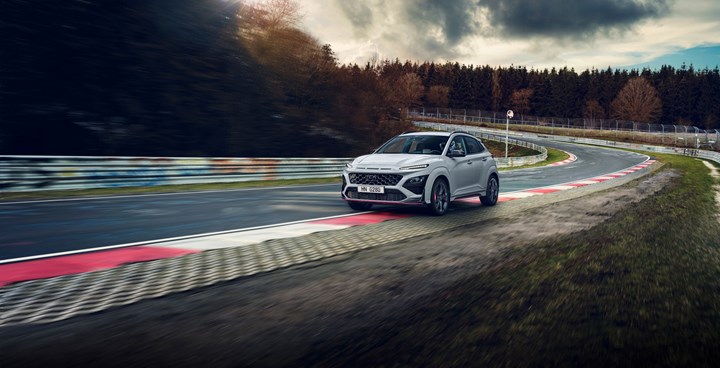
When you see the letter “N” applied to the end of the name of a Hyundai model—as in this, Kona N—know that the whole purpose is to go fast. (Image: Hyundai)
According to Hyundai, its Kona N, “Just like popular racing video games. . .has customizable N buttons that can be set to toggle driver-defined custom modes.”
Also, the “10.25-inch infotainment and digital cluster system” feature “an exclusive racing display that adds a game-like dimension with N or Sport driving modes.”
Seems to indicate that this is a car for gamers.
Recent data from Statista have it that of U.S. video gamers in the U.S., 24% are under 18 years old and 36% are from 18 to 34.
That sums to 60% who are probably keen on things of a game-like nature.
Yes, there is that whole “young at heart” manifestation.
But then mounted on the lower right quadrant steering wheel there is largeish red button with “NGS” in white.
The Red Button
The hatch is powered by a 276-hp turbocharged 2.0-liter four mated to an eight-speed wet, dual-clutch transmission (an automatic, though there are paddles at hand for shifting).
Once you engage that NGS button—and the letters stand for “N Grin Shift”—then a temporary “overboost” function kicks in and the power goes to 286 hp for a brief period.
Meaning that the young-at-heart might have a gripper when pushed back into the nicely bolstered bucket seat.
(Note: the average age for a male to get a heart attack is 65.5 years; only 6% of gamers are 65 or older.)
The point is this: Hyundai has various Konas on offer. A standard model. An N-Line, which is largely a sporty trim package. An EV. And this one.
This one is for those who are looking for a game-like experience in the real world.
Before You Know It. . .
When the Kona N was introduced last year, Albert Biermann, then-President and Head of R&D Division at Hyundai Motor Group, said, “Kona N can carve corners on the racetrack and bring excitement to everyday driving.”
Which pretty much encompassed what this car is: Something that is going to cause a rise in blood pressure from excitement and possibly result in a speeding ticket (“Sorry, officer, but I just touched that metal-surfaced gas pedal and. . .”).
The slogan that Hyundai uses for its N vehicles: “Never Just Drive.”
The adverb (just) is the key word there.
You can just drive the standard Kona subcompact SUV.
You can’t just drive the Kona N.
Game on.
///
Styling the 2023 Ford Escape
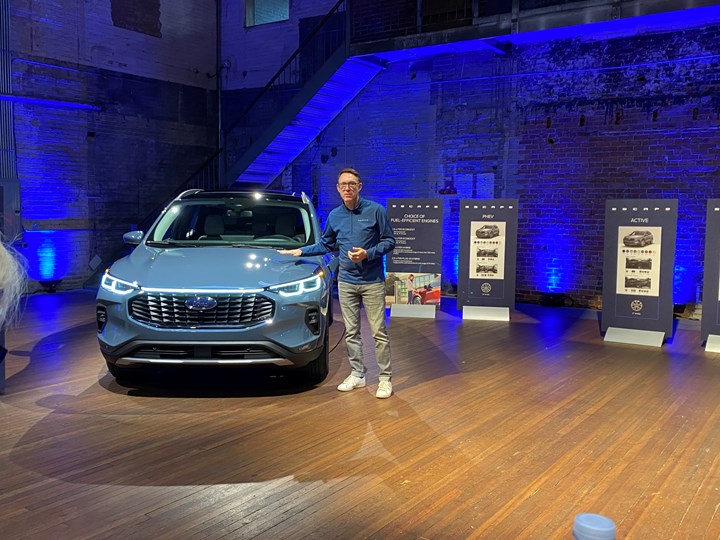
Amko Leenarts, head of Design for Ford of Europe, and the 2023 Escape. (Image: gsv)
When you think about the Ford Escape, it is probably of a perfectly pleasant small ute. It was all-new for model year 2020 and had a softer body style than its predecessor, undoubtedly because the team working on the design knew that there was a Bronco Sport on the way, a platform mate that took care of the off-road characteristics.
However, if you are in Europe, you probably think of the Ford Escape as something else. Not just as a, well, perfectly pleasant small ute.
Upscale in Europe
Amko Leenarts, head of Design for Ford of Europe, where the model year 2023 Escape got a face lift, says that in Europe, getting an Escape is a sign of having “made it in life.”
Sure, someone in Germany may quibble with that—although know that Leenarts and his team are based in Cologne—but the Escape is carries more resonance in Europe than it does in the U.S. At least for now.
Same & Different
The ’23 Escape shares the sheet metal from the A-pillars back with the ’22 models.
The back is modified with new tail lights, skid plate and the removal of the hand inset for lifting the tailgate (it is replaced with a pressure pad concealed in the area above the top of the license plate position).
The front end is a big change.
Asked about what they were trying to achieve, he replies, “Sportivity.”
Through the redesign of the hood, which has more of a center bulge without looking like something befitting a Mustang and creases that provide both form and direction, as well as a new front fascia, which includes an all-new grille, front lighting—including a LED light bar that runs across the front of the car (“from coast to coast,” he describes it, with the coasts being the inside edges of the headlamps)—and a modified area into which the fog lights are contained, the vehicle is visually wider and lower.
It isn’t. But the appearance—particularly striking in the new ST Line trim, which, with body color cladding and things like black wheels—telegraphs sportivity.
Likened to Leonardo
Leenarts describes the grille as “the Mona Lisa grille.” No, there isn’t anything particularly Tuscan about it. Rather, he says that it has more three-dimensionality than was previously the case and as one moves around the front of the vehicle it remains subtly in one’s sight lines. What’s more, the rectagularish shapes that make up the structure are individually oriented such that they pull the eye to the Blue Oval, which is located in the grille rather than on the hood, where it had been previously positioned.
Leenarts explains that in the hood orientation it is like someone looking up to the sky at an angle. Placed on the grille it is looking straight at you.
And of the light bar he says, “We wanted to give people something to talk about in the pub.” Something special.
After all, the owners have earned it.
///
Mercedes, Safety, Materials & Pink Noise
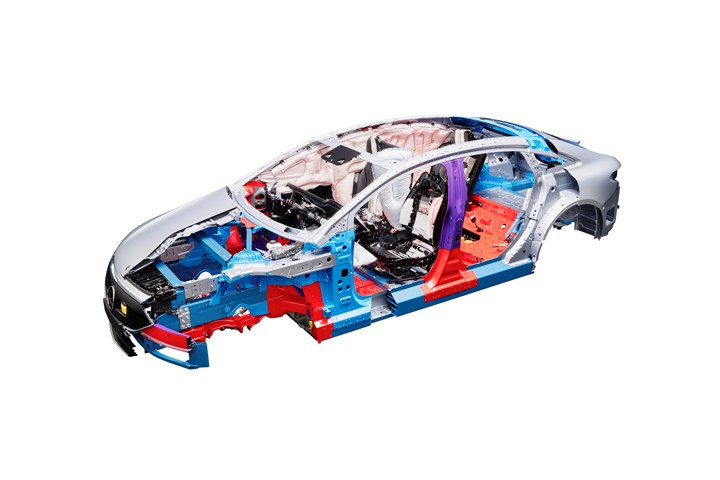
The Mercedes EQS Safety Body structure. The gray represents aluminum sheet; blue cast aluminum/extruded aluminum profiles; orange high-strength steel; purple hot-formed ultra high-strength steel. (Image: Mercedes)
Mercedes-Benz is working toward having its vehicles have no accidents by 2050.
The company knows a little something about how things can go wrong. And how to fix it.
Twenty-five years ago, in 1997, Teknikens Värld, a Swedish magazine, ran a test of the then-new A-Class. And they made a maneuver that caused the car to flip.
Moose & ESP
The so-called “moose test” led to the further development and subsequent deployment—in Mercedes’ words, “admittedly involuntarily”—of its Electronic Stability Program (ESP), which uses braking to keep the vehicle under as much control as practical in severe situations.
More widely known simply as “stability control,” it is a technology that became standard for new vehicles in Europe in 2011 and for model year 2012 vehicles in the U.S.
Further developments in the braking space have been pursued at Mercedes, such as the “TwoBox” system, which combines ESP with an electromechanical brake booster, which helps build brake pressure for hard braking, such as in automatic emergency braking situations. This is an important system for EVs, in particular.
Needless to say, Mercedes is pursuing the further development of sensor-based systems to enhance driver safety. It is working on the development of a new operating system that will more quickly process sensor inputs and better orchestrate the vehicle’s actuators.
Four Phases
But it is interesting to note that the company is also paying attention to where it deploys materials and engineers structural designs to create a safer place for drivers and passengers to be.
Mercedes has identified four phases for its safety systems:
- Phase 1: Assistance while driving. This is about everything from ride and handling to ADAS.
- Phase 2: Preparation for potential accidents. This includes items like emergency braking and even having the car speakers emit a rushing sound, or pink noise, in order to cause the ear drums to adjust to the high sound pressures that can be related to a collision.
- Phase 3: Protection in the event of an accident. Here the structure of the vehicle is important, as well as an array of airbags.
- Phase 4: Assistance after an accident. Automatic emergency calls, ventilating the interior of airbag gas and more.
There’s certainly work to be done between now and 2050.
But efforts like this are laudable.
///
Taking a Back Seat
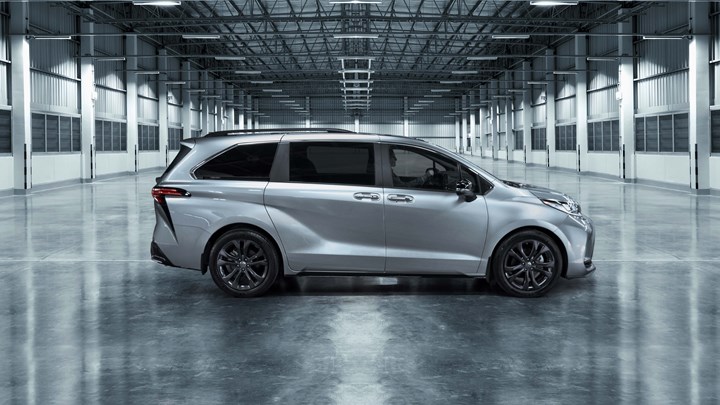
Toyota Sienna: You might want to ride in the back. (Image: Toyota)
Although passengers typically don’t like to sit in the back seat of most vehicles for more than a few minutes, let’s face it: Sometimes you don’t get to ride shotgun.
And let’s not lose sight of the fact that rear seats are where children in car seats belong, so in that case it is non-negotiable.
Consumer Reports has spent some time considering the back seats.
Emily A. Thomas, PhD, manager of auto safety at Consumer Reports:
“The rear seat has to take into account all kinds of passengers who sit there, from infants and teens to adults and ride-sharing passengers of all ages.
“But our analysis shows that many automakers don’t put the same safety features in the rear that they do in the front.”
Safety features like pretensioners and load limiters, side airbags, rear occupant reminders and seatbelt reminders.
Of the 54 2022 model year vehicles tested CR found that the top-scoring vehicle is the Toyota Sienna minivan.
It achieved 72 points out of 100.
Two points:
- Actually riding in the back seats of a minivan is not a trip in the penalty box
- A primary purpose of a minivan is to move people (whether they play soccer or not), so it make sense that protecting passengers is paramount
At the bottom of the CR list with 25 points?
The Mercedes C-Class.
(Hmm. . .seems inconsistent with the previous item. . .)
///
What Would Batman Drive?
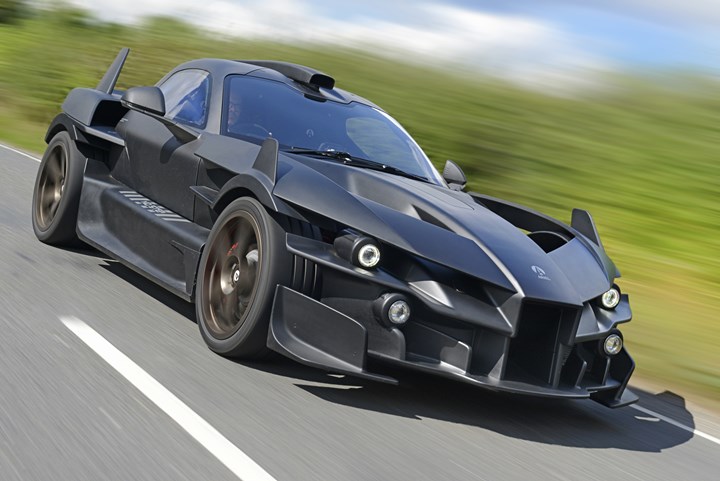
Yes, this is actually a car will be produced in volumes greater than one. (Image: Ariel)
You’d be forgiven if you thought the vehicle in that picture is the latest in Bruce Wayne’s cave garage.
It is actually the Ariel Hipercar, a high-performance EV coupe.
How high?
It has four 295 bhp wheel motors (in the AWD configuration). This means the vehicle has a total output of 1,180 bhp. Currently it has a 0 to 60 time of 2.09 seconds. The engineers at Ariel are working to achieve a sub 2-second time through full torque vectoring. (As though 0.09 seconds are noticeable.)
Powertrain testing was performed at the GKN Automotive’s Abingdon Innovation Centre in the U.K., which was developed with support from the Advanced Propulsion Centre, a non-profit that collaborates with the U.K. government to help achieve a transition to net-zero emissions vehicles (not all of which are hypercars, of course).
“Hipercar” comes from (“High Performance Carbon Reduction”).
To test the Equipmake APM motors there was considerable engineering work at GKN Automotive.
Sean Worrall, senior product manager, GKN Automotive:
“We’ve used the knowledge gained in developing the test rig and controlling such high performance to test high power machines for high performance electric SUVs, exporting this knowledge across the world to other GKN Automotive sites.”
Back to the Hipercar. . .
Power is provided by a Cosworth 800-V, 62-kWh lithium ion battery pack. It facilitates an electric range for the vehicle of 150 miles on the WLTP cycle.
(The World Harmonised Light Vehicle Test Procedure consists of four parts based on average speeds: low, medium, high and extra high, with acceleration and braking involved. One assumes that the Hipercar would spend most of its time in either low or extra high speeds—nothing in between.)
Why Just “Reduction”?
You might wonder about the name including “Carbon Reduction” and not “Carbon Elimination.”
That’s because it is available with a Cosworth 35-kW catalytic generator, a 110,000-rpm turbine range extender.
And speaking of carbon, the Hipercar features a carbon fiber body.
The chassis is a bonded aluminum tub. There are removable front and rear subframes that feature billet machined and anodized aluminum interfaces.
The mass is 1,546 kg.
The Hipercar is 4,298 mm long, 1,970 mm wide, 1,354 mm high and has a 2,685-mm wheelbase.
Although this might seem like a one-off or a concept car, listen to Simon Saunders, director of Ariel:
“The price of the four wheel drive car with range extender on the road in the UK, with all taxes, will be under one million pounds and although expensive we’re determined to make it value for money, like all Ariel products. Production HIPERCARS are around two years away.”
Yes, Bruce Wayne money.
///
Electrify America and BESS
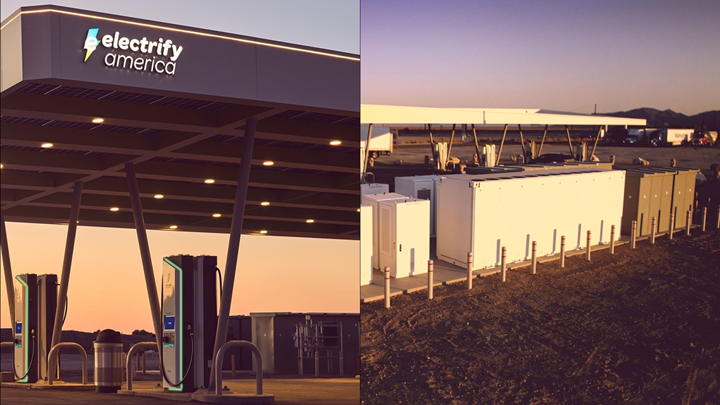
The rectangular objects on the right side of the picture handle batteries, which store energy for use at this Electrify America station. It is called into use when necessary. (Image: Electrify America)
Electrify America is taking a clever approach to storing some of the electricity that it sells to consumers.
It is called “BESS,” for “battery energy storage system.”
Yes, it is using batteries at some of its charging stations to store energy that is then used, when needed, to charge vehicles.
It has more than 150 BESS operations in the U.S.
It has opened its first megawatt BESS.
The ~1.5 MW/3 MWh energy storage system is located at its station in Baker, California.
Fair Bet
Baker, home of what is claimed to be the World’s Largest Thermometer, is on I-15 between LA and Las Vegas. Located in the Mojave Desert, it isn’t entirely surprising that Electrify America has installed a solar canopy on the roof of the station that provides a potential 66 kW.
(This solar deployment there makes considerable sense: the Mojave has some 280 sunny days per year.)
One of the concerns regarding EVs is the ability to take a road trip that is likely cover rural areas where local utilities may limit the amount of power that a charging station could pull (assuming that there is a charging station in the area).
According to Electrify America, the BESS approach of storage and subsequent distribution could be a solution to this concern.
This could allow a more-extensive network of charging stations, even in the middle of the proverbial Nowhere.
///
Bosch Replaces Diesel Component Production with Electric Motors in Charleston
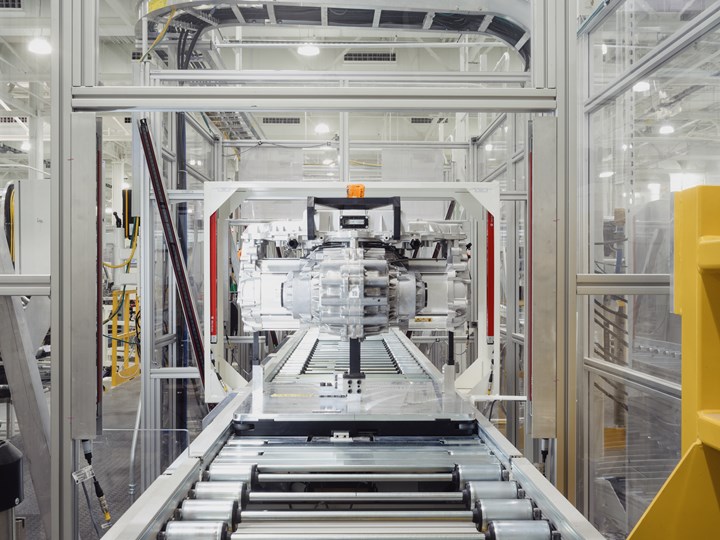
One of the customers for the Bosch electric motors is Rivian. Shown here is a Rivian drive unit that contains two electric motors and an inverter. (Image: Rivian)
At the Bosch manufacturing facility in Charleston, SC, the company has just launched the production of electric motors—rotors, stators, final assembly—in a 200,000-square foot facility that, noted Annekathrin Mueller, Bosch vice president and plant manager-Commercial, used to be used to produce diesel components.
And while the diesel operations at the plant wound down, the electromobility business is winding up at Bosch, as the company is making a $260-million investment to expand the operation by some 75,000 square feet and add it to the production by the end of 2023. It is reckoned that there will be at least 350 net new jobs by 2025 making electric motors.
At the Charleston operation—which has the most employees of any Bosch U.S. plant (~1,500)—safety components like ESP and high-pressure injectors are also being produced.
Mike Mansuetti, president, North America, Bosch, who began his career in 1988 at the Charleston facility after obtaining a mechanical engineering degree from Clemson, says that the organization is characterized by its ability to be adaptable to changes in the industry. As in recognizing the diesel business is waning and electric motors waxing.
It is interesting to note that while they’ll continue to produce injectors for internal combustion engines they’ll also be producing the modular line of electric motors that range in output from 50 to 500 kW.
Balance.
^^^
Related Content
ASCEND program update: Designing next-gen, high-rate auto and aerospace composites
GKN Aerospace, McLaren Automotive and U.K.-based partners share goals and progress aiming at high-rate, Industry 4.0-enabled, sustainable materials and processes.
Read MoreTPI manufactures all-composite Kenworth SuperTruck 2 cab
Class 8 diesel truck, now with a 20% lighter cab, achieves 136% freight efficiency improvement.
Read MoreRecycling hydrogen tanks to produce automotive structural components
Voith Composites and partners develop recycling solutions for hydrogen storage tanks and manufacturing methods to produce automotive parts from the recycled materials.
Read More“Structured air” TPS safeguards composite structures
Powered by an 85% air/15% pure polyimide aerogel, Blueshift’s novel material system protects structures during transient thermal events from -200°C to beyond 2400°C for rockets, battery boxes and more.
Read MoreRead Next
on Swedish Design, AAA and AEB, EV Readiness, Kia EV6, Rice for Tires, Calm Bentley, & Fueling Vehicles
People like Swedish designs. . .AAA finds automatic emergency braking lacking. . .EV readiness around the world. . .the Kia EV6 and addressing carbon emissions. . .Using ag waste for EV tires. . . Bentley creates calm SUV. . . What people want when fueling/charging
Read Moreon Designing and Executing for Function, Energy Effects on Manufacturing Costs, & an E-axle for Pickups
On the Citroën oli. . .the UBCO EV adventure bike. . .European energy costs. . .Stellantis and the circular economy. . .thin oil. . .Toyota C-HR review. . .ZF electric axle for pickups. . .
Read Moreon Atypical (for most of us) Modes of Transportation
A (partially) sun-powered vehicle. . .Bentley’s three-car collection. . .minimobility. . .a quick four-wheeler. . .scooter LCA. . .Porsche aluminum recycling. . .Lotus metrology. . .Christmas car. . .
Read More
.jpg;width=70;height=70;mode=crop)

